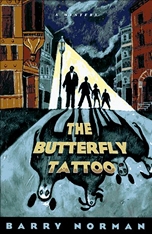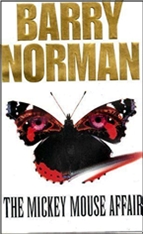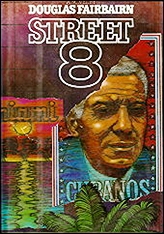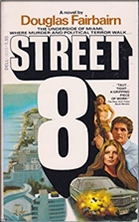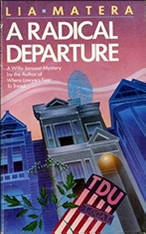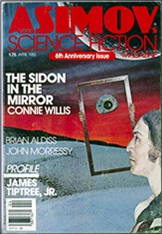REVIEWED BY DAVID VINEYARD:
DONALD HENDERSON – A Voice Like Velvet. Random House, US, hardcover, 1946. Previously published in the UK as The Announcer (Hurst, 1944), as by D. H. Landels. The Detective Club [Collins], UK, hardcover/paperback, 2018/2021, with the inclusion of the short story, “The Alarm Bell.” Introduction by Martin Edwards.
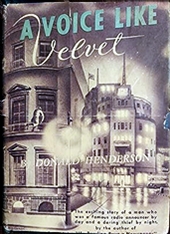
Mr. Ernest Bisham kept as still as possible behind the green velvet curtains and listened to the clock ticking, Suddenly he slipped from behind the curtains and made for the door. He went unchallenged along a corridor and opened the first door he came to. Nobody was in it, it was a bedroom. He went to the window and softly opened it. A few minutes later he was hurrying along a side street and panting slightly.
Ernest Bisham is a cat burglar, a second story man, known by Scotland Yard as “the Man in the Mask.†He is not quite Raffles or the Baron, being middle aged, married, and a bit heavier than he was when he was younger. He lives with his wife Marjorie and his sister Bess, and is both highly respected, and a fixture in every home within the broadcasting range of the Broadcasting House (think BBC which Henderson wrote for creating the first soap opera broadcast, Front Line Family, later known as The Robinsons, and the radio play The Trial of Lizzie Borden among others) as the voice of Broadcasting House, Ernest Bisham, the Announcer, newsreader, famed for his closing, “… and this is Ernest Bisham reading it,†in a voice compared to velvet.
For Americans unfamiliar with the UK and the BBC (*) it is hard to comprehend the role the legendary voice of the BBC played in dominating a culture and a way of life, From Buckingham to Whitechapel from the South of England to the Midlands and the North the voice of the BBC was a fixture, a respected and admired figure, the calm assured vaguely upper class sounding voice of a nation, particularly during the War years.
And in Ernest Bisham’s case that voice belongs to a thief.
Without berating the point, the novel quietly puts the reader into the mind and ego of Mr. Bisham but never bores with heavy-handed psychological breast beating. Finding that balance between the melodrama of a thriller (the realm of most gentleman cracksmen) and the dark near Gothic brocade of the serious crime novel Henderson manages to walk a tightrope never making a misstep. Though not as dark as Gerald Kersh’s Prelude to Midnight and Night and the City, Henderson is in the same vein of sharply observed recognizable humans in crisis.
Henderson was an admirer of John Dickson Carr, but he began writing in the shadow of Francis Iles (Anthony Berkeley) and his work is informed by the Iles’ books Malice Aforethought and Before the Fact, two works that freed the British crime novel from the Golden Age mode of the detective story and aristocrats dying in vast manor houses on isolated weekends.
Most writers are lucky to write one classic genre novel over long careers. Some have more, but they are scattered over years of writing and working in the field, and some few like Dashiell Hammett and Raymond Chandler have their whole output considered classics.
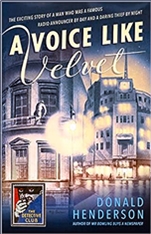
But it is a rarity to find a writer who only wrote three books, two in the genre of crime fiction, and those two books both classics in the field.
Mr. Bowling Buys a Newspaper was Henderson’s first book, and the better known of the two, the story of a serial killer who only reads the paper after a kill in hope that the police are going to stop him before he kills again. That book was highly praised by critics and writers including Raymond Chandler (who claimed to have read it three times) and Ian Fleming.
A Voice Like Velvet took a more torturous route to its stature as a classic of the crime genre.In fact the book was first published in the UK in 1944 during the War as a mainstream novel as The Announcer, and it was not until its American publication that it was recognized as a classic of the crime genre under the better known American title by Random House.
Driven by the compulsion to spice his life with excitement, Bisham’s chosen manner is cat burglary, he is well aware that he risking everything he has earned, that his marriage, his life, his prestige, are all endangered by his recklessness, and now Chief Inspector Hood has Bisham in his sights and is having him followed, which makes the game even more exciting. As Hood assures him cat to potential mouse:
“I know the public likes to weave its own romance out of things, eh? The life of a detective is supposed to be the most exciting life!†he laughed. “And so is the life of an Announcer, Mrs. Hood assures me of that,†he laughed again. “And so is the life of a cat burglar! Or I suppose! I suppose the public will be very upset if the Man in the Mask is sent to prison. There’s something unromantic about years of penal servitude!â€
While there is suspense and action in the book it is not a thriller. Like Iles, whose work inspired it, the suspense rises from the thoughts and actions of the protagonist, his compulsion, his quick wits, and his inevitable mistakes, but unlike Iles, A Voice Like Velvet would make a delightfully dark Ealing comedy
This was Henderson’s best reviewed novel despite its first small print run. He died at age 41 shortly after it was published in the States under its better known title, and was recently brought back in print in the UK as Velvet by the Detective Club with an attractive jacket, and introduction by genre writer, historian, and editor Martin Edwards, and with “The Alarm Bell†a powerful short by Henderson.
A Voice Like Velvet is well worth your time, a classic of British crime fiction both charming, suspenseful, and ironic.
(*) For anyone interested there is another classic of BBC crime fiction, Death at Broadcasting House (1934) by Val Gielgud and Eric Maschiwitz as Holt Marvell, which was filmed and could recently be seen on YouTube.
